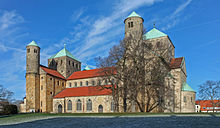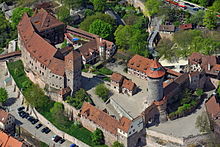Middle Ages
![]()
This article is about the historical period. For the scientific journal, see The Middle Ages.
The Middle Ages are the period in European history between the end of antiquity and the beginning of the modern era, i.e. roughly between the 6th and 15th centuries. Both the beginning and the end of the Middle Ages are the subject of scholarly discussion and are regarded quite differently.
In the transition from Late Antiquity to the Early Middle Ages, the political and cultural unity of the Mediterranean region shaped by Greco-Roman antiquity broke down. While the Byzantine Empire in the East remained intact, the Western Empire declined in 476. New empires formed within (such as the Frankish Empire, the Visigothic Empire on the Iberian Peninsula, and the empires of the Anglo-Saxons in Britain) and outside (such as the dominions of the Slavs in eastern and southeastern Europe and the new empire formations in Scandinavia) the former Western Roman Empire. These empires were populated by the resident Romanized population and groups that migrated during the Migration Period (Germanic tribes and Slavs).
While the ancient core area was already Christianized, the remaining, pagan (heathen) areas of Europe were Christianized in the Middle Ages. In the early Middle Ages, the basic political order of later times was essentially formed. The following High Middle Ages were characterized by the upswing of economy, science and culture. The late Middle Ages saw the slow transition to the early modern period.
With Islam, a new religion emerged in the 7th century, which spread as a result of the Arab conquests in West and Central Asia, North Africa and also in parts of Southern Europe, before Christian rulers initiated the reconquest in Spain (Reconquista) and Southern Italy/Sicily. In southeastern Europe, on the other hand, the Ottomans continued to advance from the late 14th century onwards.
The predominant social and economic form of the Middle Ages was feudalism. The basic features of this period were a society organized according to estates, a world view determined by Christianity, a Christian-influenced science and literature, architecture, art and culture, as well as Latin as a common, overarching language of education. After the Great Schism of 1054, both the Catholic Church and the Orthodox Church sought the unity of Christianity under their umbrella. However, these efforts failed.
Of great importance for "Christian" Europe were the Jews. Due to the prohibition of interest by the Catholic Church, Christians were forbidden to conduct monetary transactions, but not the Jews of other faiths. They were the subjects of the sovereigns and were only reluctantly tolerated as a minority. Due to anti-Judaism in the Middle Ages, they were victims of Jewish pogroms and expulsions.

Cité of Carcassonne

Romanesque church St. Michael in Hildesheim
Chronological order
The term "Middle Ages" refers primarily to the history of the Christian West before the Reformation, because the term is rarely used in connection with non-European cultures (see below for the term in the context of the history of India, China and Japan). It thus refers mainly to the European continent and the British Isles. Roughly speaking, the Middle Ages are placed in the period from 500 or 600 AD to about 1500. Much more concrete are the following reference dates:
The European Middle Ages extend roughly from the end of the Migration Period, whose end is usually dated in research to the year 568, to the age of the Renaissance since the middle of the 15th century or until the beginning of the 16th century. Concerning the problem of dating the beginning of the Middle Ages and the following development see also End of Antiquity, Late Antiquity and Early Middle Ages.
The dating approaches are not always uniform, because it depends decisively on which aspects of the development are emphasized and which region is considered in each case. For example, if one focuses on the influence of Islam and the conquest of large parts of what was once Roman territory by the Arabs, and looks at the eastern Mediterranean rather than western Europe, one can see Muhammad's Hijra (622) or the beginning of Arab expansion (from 632) as the end of Late Antiquity and the beginning of the Middle Ages. Similarly, there are different dating possibilities for the end of the Middle Ages, for example the invention of printing (around 1450), the conquest of Constantinople (1453), the discovery of America (1492), the beginning of the Reformation (1517), or even the Great Peasants' War (1525). Other approaches extend the period even more (so-called "long Middle Ages" until the 19th century, advocated e.g. by Jacques Le Goff), but these are minority opinions.
If we focus on individual countries, we can arrive at different key dates. For example, antiquity ended much earlier on the Rhine or in Britain than in Italy, Asia Minor or Syria, due to the developments there during the migration of peoples. On the other hand, at the beginning of the 15th century in Italy, for example, the age of the Renaissance had already begun, while the same period in England is still considered to be the Middle Ages. In northern Europe, the Migration Period is followed by the "Germanic Iron Age", which in Sweden is replaced by the Vendel Period (650-800). In Scandinavia, the Viking Age begins around 800, ends in 1050 and then turns into the "Nordic Middle Ages".

Nuremberg Castle as an example of a castle in the Middle Ages
Jews in Medieval Europe
→ Main article: History of the Jews (Middle Ages)
In medieval Europe, the Jews were a minority with their own traditions, culture, language and religion. First in the East Frankish Empire, then in the Holy Roman Empire, they were subject in a special way to the king or the Roman-German emperor, but they were also subjects of other lords. In Central Europe they interacted with a society shaped by Christianity that was hostile to them, and in the Iberian Peninsula, until the Reconquista, with one shaped by Islam, which knew how to use their abilities. The Jews living in the Iberian Peninsula in the Middle Ages are called Sephardim, those living in the rest of Europe are called Ashkenazim.
Christians were forbidden by canon law to lend money at interest until the 15th century. Not so the Jews. Since they were forbidden to practice a trade according to the guild and to engage in agriculture, they earned their living in trade, as pawnbrokers or in the interest and exchange business.
In the early Middle Ages there were hardly any violent attacks against Jews, who already enjoyed a thoroughly privileged special position in the Frankish Empire, although they were legally restricted. Until the beginning of the First Crusade (1096), the Jews lived relatively safely in medieval Europe. In the course of this, however, many Jews were then faced with the choice of "baptism or death". The Crusaders first wanted to get rid of the "infidels" in their own country. Thousands of Jews who did not want to convert to Christianity were slain by the Crusaders. Only in very few cases (for example in Speyer by the episcopal city lord) were Jews protected from attacks.
In the following period there were repeated expulsions of Jews and violent attacks, as in France and England in the 13th century. With the plague, a new wave of pogroms against Jews began in 1349. They were accused of poisoning the wells in order to exterminate all Christians. The survivors settled in Eastern Europe.
The late Middle Ages into the early modern period were marked by increasing hostility towards Jews. The Jews living in the cities were forced to live in ghettos. After the Catholic Church relaxed its ban on interest, they lost economic importance. Increasingly, Christians - now tolerated by the Church - were now also active as merchants and as moneylenders, including burghers and high clergy. But not only financial, but also political and religious causes weakened the position of the Jews. In the society shaped by Christianity, religious hatred against those of other faiths grew. In interaction, religious, socio-psychological, political and economic moments led more and more often to anti-Jewish actions. The result was the expulsions of Jews and the pogroms of the late Middle Ages, which did not end until the 16th century.

Old synagogue in Erfurt, 2009
Questions and Answers
Q: What is the Middle Ages?
A: The Middle Ages is a period of about a thousand years in European history, starting around 476 CE and ending around 1492 CE. It is also referred to as "the Age of Faith" due to the growing popularity of Christianity and Islam during this time.
Q: How was the early Middle Ages viewed by past scholars?
A: Past scholars wrongly believed that there was very little culture, good literature, or art, or progress during this period so they called it "the Dark Ages".
Q: What happened to Europe after the fall of the Roman Empire?
A: After the fall of the Roman Empire, Europe experienced mass migrations, wars, and plagues which devastated it. This caused a lot of new knowledge gained by Romans to be lost.
Q: Who became Emperor of the Romans in 800 CE?
A: Charlemagne became Emperor of the Romans in 800 CE. He promoted order, education, and civilization which helped Europe slowly regain what it had lost.
Q: What were some consequences of living during this time period?
A: People's lives were short and difficult due to wars and plagues killing millions across Europe and Asia. There was also continuous violence for 300 years until feudalism decreased some violence.
Q: What nations formed across old Western Roman Empire during this time period? A: Nations that formed across old Western Roman Empire included England, Scotland, Hungary, Spain, Portugal, Poland Lithuania Denmark Norway France (which evolved from realm Franks).
Search within the encyclopedia